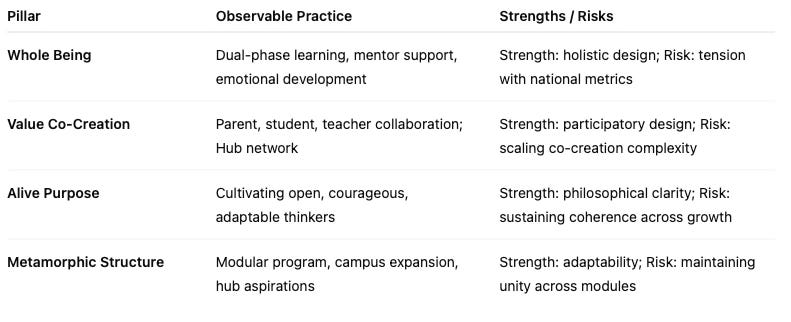Helikon School - Case Study
Crafting Autonomy, Creativity, and Whole Child Learning in Romanian Education
Context and Overview
Name / Location: Helikon School(Helikon-Bucharest); an alternative private school and educational hub.
Authorization: School is authorized by the Romanian Ministry of Education; operates primary and gymnasium levels (class zero → class VIII).
Mission & Identity: Combines standard academic rigor with “progressive, alternative learning modules” that respond to children’s individual needs, emotional development, and interdisciplinary exploration.
Size / Community Use: Over 200 students, ~35 teachers and administrative staff using Kinderpedia as management / communication platform.
Leadership / Founding Vision: Founded and led by Oana Moraru (educational entrepreneur) with a vision to shift schooling norms.
Unique Features: The daily program splits between a more structured, core instruction in the morning, and in the afternoon offers a large menu of personalized, exploratory learning experiences (atelier, research, interest modules).
Thus, Helikon presents a strong candidate for transformation toward aliveness in education — mixing structure and experimentation, autonomy and coherence, academic and holistic child development.
1. Whole Being — Fostering the Whole Child & Educator
Helikon makes explicit the goal of attending not only to intellectual growth, but emotional, social, and personal development.
Practices & signals:
Two-phase daily model: Mornings with structured, measurable learning; afternoons with personalized, interest-based modules.
Mentors & instructors in ateliers: Not just teachers, but guides who support individual growth.
Human interactions & authority + motivational support: The school describes authentic human interactions, firm teacher authority but balanced with motivational mentoring.
Values of openness, adaptability, courage: These are central to the school’s stated “mentalitate deschisă” (open mindset).
Early childhood / kindergarten: emphasis on holistic development, socio-emotional balance and creativity from early years.
2. Value Co-Creation — Education as a Collaborative Ecosystem
Helikon is not just a content delivery institution; it frames itself as a participatory, evolving community of students, teachers, and families.
Manifestations:
Parental involvement & volunteerism: The school encourages parent participation and shared responsibility.
Ateliers and modules co-designed by learners / interests: The afternoon module menu allows students to choose paths aligned with their inclinations.
Use of Kinderpedia: Helikon is a user of the Kinderpedia platform to integrate parent-teacher collaboration, communications, and administrative flows — a platform that itself enables co-creation of the educational experience.
Network / Hub ambitions: Helikon Hub (educational hub) runs innovative workshops for preschoolers, and acts as a model for mentorship programs across schools.
Curricular hybridization: The curriculum merges national standards with added progressive / alternative pedagogy, co-created with teachers adapting to student needs.
3. Alive Purpose — Cultivating Open Minds, Agency & Contribution
Helikon’s expressed purpose is more than academic excellence — it aims to nurture open, adaptable, courageous minds. From its mission statements and descriptions:
Mission phrasing: “Să construim împreună o mentalitate deschisă, adaptabilă și curajoasă...” (to build together an open, adaptable, courageous mindset).
Vision statement: To become a model of progressive pedagogy, of innovative learning technologies, for children, teachers, and families; students will be “integral, passionate, authentic contributors to communities.”
Philosophical stance on grading: Oana Moraru publicly critiques rigid grading (“Nu cred în nota 10!”) as part of her educational philosophy.
Adaptation to new tools and AI: Helikon leadership embraces tools like ChatGPT in learning, seeing them as opportunities for intelligence augmentation rather than threats.
This purpose orients Helikon toward evolving learners who can contribute meaningfully — not just test well.
4. Metamorphic Structure — Flexible, Evolving Educational Design
Helikon’s structure exhibits signs of adaptive design rather than static hierarchy.
Structural signals:
Three-location / multi-campus model: Helikon exists in Bucharest, with preschool/primary/gymnasium versions.
Helikon Hub role & network aspiration: The notion of Helikon Hub suggests a central node that supports extension of pedagogical practices beyond its own walls.
Program separation (core + exploratory): The structure of morning core and afternoon atelier modules allows modular adaptation of learning pathways.
Managed expansion & new facilities: The gymnasium recently moved to new renovated buildings to support growth.
Governance and Decision Flow — Curatorial + Participative
Although internal governance is not fully public, Helikon’s external signals point to:
Principle-based governance: The educational philosophy (open mindset, courage, adaptability) appears to guide decisions more than rigid rules.
Decentralized educator autonomy: Teachers likely have latitude to shape atelier content, respond to student interests.
Parent / community voice: The school actively engages parents, publishes events, communicates openly — so accountability is partly public.
Leadership as steward: Oana Moraru has spoken about delegating authority, building independence of the institution beyond the founder.
Governance seems hybrid — combining central vision with distributed autonomy.
Systemic Integration
Here’s how Helikon’s alignment across the four pillars looks in summary:
Helikon shows emergent coherence — many signals of an educational living system, though also balancing pressures of standardization, scale, and infrastructure constraints.
Lessons for Other Organisations (especially in education)
Design for dual rhythms — balance structured foundations with exploratory, student-driven time.
Embed purpose in language and practice — clarity of educational mission helps align all levels.
Foster teacher agency and autonomy — allow practitioners to co-author the learning environment.
Engage families and communities as co-creators — learning ecosystems extend beyond classroom walls.
Prototype structural adaptation — new pedagogies require experiments, feedback loops, and readiness to pivot.
Institutionalize reflection — make feedback, adaptation, and continuous improvement part of the system.
Conclusion
Helikon School is a compelling example from Romania of a school moving toward aliveness in education. By combining academic rigor with holistic development, by inviting co-creation with students and families, and by evolving structure and governance, Helikon stands as a prototype of what schooling might become — not a factory of tests, but a living ecosystem that cultivates human potential.
Enjoy reading and applying these materials. If you’d like to receive additional information regarding Alive Organisations topic please subscribe below.


